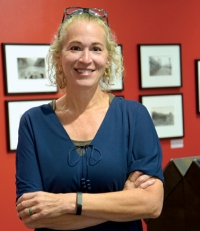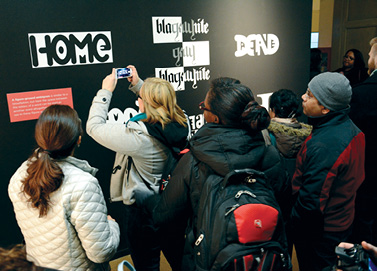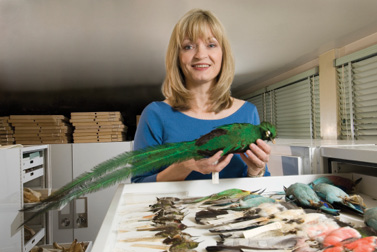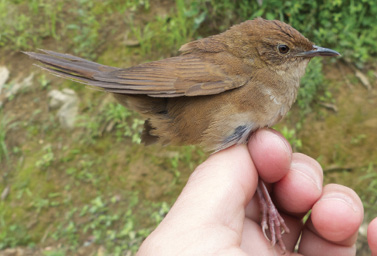Introducing New Models for Successful Teaching and Learning: The MSU Museum Collaborations

Lora Helou, interim director of the MSU Museum.
As it is traditionally understood, the responsibility of a museum is to gather and house various collections or artifacts—cultural or scientific—and exhibit a small portion of those collections for the edification of the museum-going public. Visitors expect a museum to draw on these collections and present the public with a changing schedule of exhibits. Lora Helou, interim director of the MSU Museum since 2013, said that this museum aims to challenge some of these expectations and expand the idea of what a museum does and can do. "We're expanding into models for successful learning," she said. "It's not exclusive to our own artifacts anymore."
Helou's efforts have done just that; they have also created opportunities for the Museum to partner with MSU researchers to create new kinds of exhibits and collections. As the museum reaches out, imagining new ways to meet its mission, new partners have come on board. In turn, these partners have created new models for collaboration and given researchers the opportunity to think differently about their work, broaden their audience, and find partners around the world for furthering their knowledge.
With its mission to explore both the natural and cultural history of Michigan, the Great Lakes, and the world, the MSU Museum is in a unique position to work with researchers from various disciplines. What follows are two examples of projects that the museum has worked on with MSU professors from the colleges of Education and Natural Science.
Deep Play

The Deep Play exhibit at the MSU Museum.
Not many people hear about the various research interests of professors in disciplines outside their own. A biologist measuring photosynthesis will rarely keep up on the engaged scholarship of a philosopher working with indigenous populations on responses to climate change. By working with professors from every college on campus, the museum creates a space where these diverse research interests can be shared with others on campus and with a larger public audience.
This past year saw the first ever collaboration between MSU's College of Education and the Michigan State University Museum. Dr. Punya Mishra, professor of educational psychology and educational technology and director of the Master of Arts in Educational Technology program, worked with the Museum to co-produce an exhibit titled, "Deep Play: Creativity in Math and Art Through Visual Wordplay" (deep-play. com/creative). Displayed in the Creativity-Art-Science Gallery, the exhibit explored the world of ambigrams—stylized word forms that hold different meanings when looked at from different perspectives.
The playfulness of ambigrams can be deceiving. Underneath the fun exterior, there are deeper discussions to be had about math, language, and human perception. Ambigrams have interested Mishra for years, and he has found that the practice of creating and interpreting ambigrams reveals the importance of play in the process of learning. The process of creating an ambigram is a highly engaging activity that challenges the viewer to search for solutions. These solutions can be elegant, and they are often surprising.
Ambigrams are interesting in the ways they engage different disciplines, in particular mathematics and design. "I am not a mathematician, or artist, or designer, though I work at the intersection of these disciplines," Mishra said. "This exhibit helps present the nature of our research. It's transdisciplinary." By getting outside the College of Education and exhibiting at the museum, that transdisciplinary nature can be shared across disciplines.
Typically, ambigrams are displayed in two dimensions, and in the past, Dr. Mishra has published ambigrams in journal articles and on his Deep Play website (punyamishra.com). The museum exhibit, however, allowed visitors to experience ambigrams in three dimensions. This not only made the exhibit more interactive for visitors; it challenged Mishra to consider new ways of engaging an audience with his research.
"The exhibit puts a very public face on our deeper research interest," said Mishra, "which is learning and the importance of play." Not only were museum guests seeing his work with ambigrams; the exhibit also led to an interview on Michigan Radio's Stateside with Cynthia Canty.
In many ways, Mishra's interest in ambigrams is part of a wider philosophy. He finds them interesting so he looks for ways that this interest might enrich his teaching. It's something he encourages his students to do, especially in their role as future educators. "When you look at educators who have won teacher awards, you find that they bring their personal interests to their teaching," said Mishra. "Their avocations inform their vocations."
To create the exhibit, Mishra worked closely with Sandra Sawaya, a doctoral student in educational psychology, and Teresa Goforth, exhibitions manager for the MSU Museum. Both Mishra and Sawaya credit Goforth as being an irreplaceable help preparing the exhibit. She helped them navigate their way through the new territory of museum exhibitions.
Sawaya became interested in ambigrams in a design class taught by Mishra, where she became intrigued by the ways design could be used to communicate and problem-solve. This interest led to her participation with the museum exhibit. "This experience helped me think of design as an effective, powerful, and engaging way to represent ideas," Sawaya said. "It helped me think of design as a tool to create meaning and elicit reactions and emotions from others."
AVoCet

Pamela Rasmussen, MSU integrative biologist and assistant curator at the MSU Museum.
With the ubiquity of digital media, the 21st century poses several challenges to museums. People expect more sophisticated displays, more interaction, more bells, more whistles. At a deeper level, however, the digital revolution offers curators a whole new way to look at collecting. Not all exhibits require walls and a roof, and collections can more easily be shared with an international audience. In fact, some collections make it possible for individuals around the world to participate in the co-creation of knowledge.
A major activity of ornithological research is the determination of how many bird species exist. The task is not always straightforward, and many birds may long remain considered a sub-species (and therefore of lesser importance to conservation) until enough data emerges to challenge that classification. Birds are identified by a number of characteristics, including size, coloring and plumage, habitat, and habits. One important identifier is bird sounds or vocalizations.
Researchers and amateur birders have been recording bird calls for generations, but the technology to record, store, and widely share these calls has not been available until recently. New technology and web-based social networks have made way for sites like xeno-canto (xeno-canto.org), which allows users to share their own bird recordings online. These sites, however, are like Wikipedia in that they rely on knowledgeable users to verify information and query sketchy contributions. Like a Wikipedia entry, the data on these sites are generally accurate, but often do not provide enough information on how identifications were made for the needs of someone trying to use them for scientific purposes.

The Sichuan Bush-warbler is a new species recently discovered by Dr. Pam Rasmussen and a team of ornithologists.
What had been missing was a database of more researcher-qualified recordings, assembled with significant contextual information, and cataloged so that recordings could be cited in research papers. To answer that need Dr. Pamela Rasmussen, MSU integrative biologist and assistant curator at the MSU Museum, helped launch the Avian Vocalizations Center (AVoCet) in 2008, building off the collection of field recordings that she had been making for her own research. As expressed on the AVoCet website (avocet.zoology.msu.edu), "Project AVoCet aims to provide a global database of well-documented, downloadable bird sounds in aid of environmental and ornithological research, conservation, education, and the identification and appreciation of birds and their habitats."
An important part of providing this global database is gathering quality data. "We need recordings that can serve as baseline data and can be independently verified," Rasmussen said. "So uploading recordings takes a lot of time. There's a lot of information that goes along with each recording."
Since its creation, the database has grown to almost 18,000 recordings of almost 4,700 bird species, much of the work being done by student workers and volunteers here at MSU. One of those students was Joseph Shemanski, who came to work with Rasmussen as part of the Professorial Assistantship Program. His primary research was a project that looked at the vocalizations of two Southeast Asian crows. When he wasn't up to his ears in sonograms of Corvus enca and Corvus macrorhynchos, he helped prepare recordings for the AVoCet database.
"My experience with AVoCet allowed me to interpret sonograms, which are visual representations of sound, in a program called Raven, with great efficiency," Shemaski said. "I was able to see sound and then hear it. I could predict what a call would sound like just by looking at it." Shemanski credits the experience with a new interest in the vocalizations of birds. He's also begun wondering more about vocal learning and how it differs between language regions in Europe.
These recordings have been used by researchers around the world. Being able to have confidence in the data—being able to identify the recorder and the context of the recording—has led to AVoCet recordings being used in a number of journal articles.
- Written by Matthew Forster, University Outreach and Engagement
UOE Broadens Access to the University